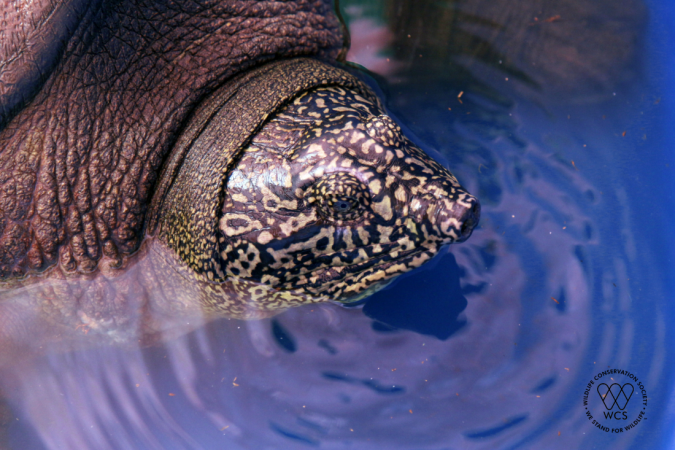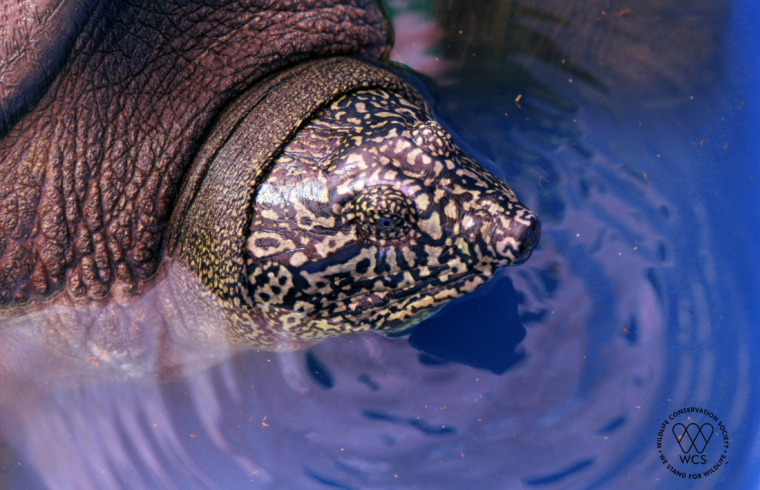
HA NOI, Viet Nam–The Ha Noi Department of Agriculture and Rural Development, in collaboration with the Asian Turtle Program (ATP) of Indo-Myanmar Conservation (IMC) and the Wildlife Conservation Society (WCS) have made dramatic progress to possibly prevent the extinction of Swinhoe’s softshell turtle (Rafetus swinhoei) also known as the Yangtze giant softshell turtle or or Hoan Kiem turtle.
One week ago, scientists revealed that genetic testing has confirmed a female turtle captured on October 22, 2020 in Dong Mo Lake is definitively a Swinhoe’s softshell turtle. This confirmation means there is now one known male Swinhoe’s softshell turtle at Suzhou Zoo in China; and now the female captured in October 2020 in Dong Mo lake, Ha Noi, Viet Nam.
Authorities believe there is at least one more of these turtles in Dong Mo Lake and another in nearby Xuan Khanh Lake. Conservationists hope to capture and determine the sex of the other turtles in both Dong Mo and Xuan Khanh Lakes this coming spring. Ultimately, conservationists aim to ensure at least one male and female are given a chance to breed to ensure this species can return from the brink of extinction.
Nguyen Huy Dang, Deputy Director of Ha Noi Department of Agriculture and Rural Development, said: “This is a very important mission and it needs to be done effectively. We have been seeking advice and consultation from the Ha Noi People’s Committee to promulgate guiding documents and collaboration with international organization to execute our development and conservation plan of Rafetus Swinhoei.
The department of Ha Noi Fisheries continues to implement the Plan #200 from the Ha Noi People’s Committee to revive and preserve the Swinhoe’s softshell turtle, a rare, precious and endangered species in the red book of Viet Nam and in the world”
Timothy McCormack, Program Director of the ATP/IMC, said: “It is so important that we are taking these steps, confirming the sex of the identified animals, and in the case of the animal in Xuan Khanh Lake, confirming the species, as currently this has only been based on Environmental DNA. Once we know the sex of the animals in Vietnam, we can make a clear plan on the next steps.
Hopefully we have a male and a female, in which case breeding and recovery of the species becomes a real possibility. At the same time our surveys in other areas of Vietnam suggest other animals might still survive in the wild, we need to be looking at bringing these together as part of the broader conservation plan for the species.”
“In a year full of bad news and sadness across the globe, the discovery of this female can offer all some hope that this species will be given another chance to survive, said WCS Viet Nam Country Director Hoang Bich Thuy. “Over hunting and habitat destruction have contributed to the demise of this species. In Viet Nam, with the leadership of the government, we are determined to take responsibility to give this species another chance.”
Andrew Walde, Chief Operating Officer of the Turtle Survival Alliance, a technical advisor on this project said, “This is the best news of the year, and quite possibly the last decade, for global turtle conservation. As the most endangered turtle on Earth, a tremendous amount of energy and resources have been dedicated to the preservation of Swinhoe’s softshell turtle.”
Following the loss of the only known female at the time in 2019, the confirmation of this wild specimen as female is a cause for celebration for all those who have worked tirelessly to see this turtle species survive. We commend the dedication and leadership of the Vietnam Government, Ha Noi DARD, and our colleagues at ATP and WCS. We look forward to continuing to provide technical expertise to the project in 2021, and continued successes.”
Previous to this discovery, there had been a major effort to breed the remaining two known remaining members of the species. Then, the last known female Swinhoe’s softshell turtle died on April 13, 2019, during recovery from anesthesia after an artificial insemination procedure in Suzhou, China. T
he male and female turtles, which had failed to produce offspring naturally since they were brought together in 2008, were determined to be healthy for the procedure, and similar anesthesia procedures had previously been performed without incident. When the female died, the hope for the species turned to the possibility of additional turtles in two different lakes in Viet Nam, Dong Mo Lake and Xuan Khanh Lake.
Since early 2019, with technical support from the ATP/IMC and WCS, Ha Noi Fisheries Department had organized various consultations and review meetings to develop a technical approach for the discovery and capture; conduct more surveys of Dong Mo Lake; and select trapping locations. The plan was delayed due to COVID-19 lockdowns in Viet Nam, preventing international team members, including veterinary teams and turtle experts, travelling to Viet Nam due to travel restrictions.
In September 2020, a team went back into the field; including local fishers, the Ha Noi Fisheries Department and the ATP/IMC and WCS personnel. They spent weeks putting out a series of nets in the 1,400 ha lake (about 3,459 acres) to create a fenced-in 90 ha (about 222 acre) capture zone. On October 22, 2020, an animal was seen next to the net fence and a quick-thinking team member was able to capture the animal with the help of a local fisherman.








